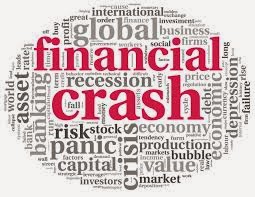False Flag Alert: Banks Preparing for an Economic Crash
February 7, 2014
Just received this article from a reader via email today. Interesting timing considering February/March is the month all the earmarked "money" is supposed to flow out from the Central Banking systems into the various national and international projects for the new fiscal year. I say interesting because there is no "money." We had a lengthy discussion a few days ago with Heather who confirmed everything is frozen and the big wigs are freaking because they can't get any of the accounts to move. I would be lying if I said I had even a partial grasp of understanding on how any of the global banking ponzi scheme works as it pertains to this particular part of the process. What I DO know is all the signs, including this article and many others reporting a big financial stir over the course of the 60 days are everywhere. Whatever the case, it's not a matter of "if" but "when" the whole house of cards will come tumbling down. My guess is it will be sooner rather than later. As usual, consider the data and then defer to your highest discernment. ~BK
Either the new Federal Reserve Chairman Janet Yellen is a prepper, or there is something afoot in the world of banking. If she is a prepper, I missed any indication of that in her background. Bankers typically talk in terms of contingency plans and liquidation programs, not prepping for disasters.
In January of this year, Supervisory Regulation (SR) 14-01 was issued in regarding the need for bank preparedness particularly for the eight bank holding companies (BHCs) in the United States. According to the memo, there are eight Bank Holding Companies that appear to be at risk and that risk threatens the financial stability of the United States. These eight companies are Bank of America Corporation, Bank of New York Mellon Corporation, PLC, Citigroup Inc., Goldman Sachs Group, Inc., JPMorgan Chase & Co., Morgan Stanley, State Street Corporation, and Wells Fargo & Company.
The memo, dated January 24, was the first one of the year. It was sent from Michael Gibson to the top banks to stress increased supervisory expectations. Gibson stated,
“… the Federal Reserve is issuing this letter to clarify the heightened supervisory expectations for recovery and resolution preparedness for the eight domestic bank holding companies that may pose elevated risk to U.S. financial stability. “
Shortly after the “increased supervision” of the big eight, customers at other “not eight” banks started getting notices of bank drills where services will be limited. One example is the Bank of Albuquerque, as shown below.
While this screen shot is from their website, a similar email advisory went out to all of their customers. The Bank of Arizona, Bank of Oklahoma, and the Bank of Texas have all been mentioned as having this drill. All of these banks are owned by BOK Financial. They also own Bank of Arkansas, Bank of Kansas City, Colorado State Bank and Trust, BOSC, Inc., Cavanal Hill, TransFund, HomeDirect Mortgage so it may be that these institutions will announce they are also involved in this drill. This may be a corporate activity, or something greater in scope.
What makes this all the more curious is that FDIC has lawsuits going on in the Southwest region against banks. It doesn’t appear to be connected to any of these banks or the drill, but the memo from the Fed requiring more supervision of the “Big 8,” the drills in the south that include the S.W.I.F.T. system, and the lawsuit taken together does give one a moment of pause. The whole matter does seem a bit auspicious to the causal observer. Banks temporarily shut down, calls for increased bank supervision back east, the looming debt ceiling and discussions of default once more coming from the administration casts the drill in a surreal perspective. The backdrop of 4 banker suicides last week, including Mike Dueker at Russel Investments, lingers in the mind as well, and all of them worked in the area of forecasting and data analysis. Late last month HBC started restricting cash withdrawals by customers. One can’t help take notice of these coincidental events and ponder if there isn’t something more afoot.
Michael Deuker, monetary economist who did ground breaking research on yield to maturity curves for use in predicting business cycles found dead under the Tacoma Bridge in an apparent suicide. Formerly the Chief Economist of the St. Louis Fed and an avid researcher, he worked for Russell Investments as a writer. His work will be missed.
These events have not escaped the notice of the Youtube community either. Below is from one customer who received a notice. Notice that it appears that a bank in New Zealand will also conduct a drill at the same time. It is unknown if it is connected to this drill or a coincidence.
Dave Acton also put out video on the matter with supplemental commentary that may be of interest to readers. It include additional commentary from Acton on cybersecurity and additional commentary on potential changes in currency policy






wow brian! thank you for the head's up….
ReplyDelete